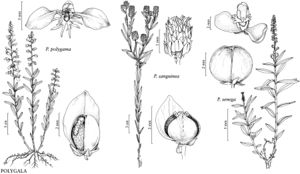Polygala polygama
Fl. Carol., 179. 1788.
Herbs short-lived perennial or biennial (rarely annual), single or multistemmed, (1–) 1.5–3 (–5) dm, mostly unbranched, or sparsely branched distally; from taproot or fibrous-root cluster. Stems usually erect, rarely somewhat sprawling, glabrous. Leaves usually alternate, sometimes subopposite or opposite when leaves scalelike proximally (less than 1 mm); sessile or subsessile, sometimes with narrow petiolelike region to2 mm; blade spatulate to obovate or, sometimes, scalelike proximally, linear-oblong or elliptic to oblanceolate distally, (8–) 15–30 (–40) × 2–6 (–8) mm, base acute or cuneate, apex obtuse to rounded or, sometimes, acute proximally to mostly acute distally, surfaces glabrous. Racemes loosely cylindric, open, elongate, (2–) 5–10 (–25) × 0.8–1.4 cm; peduncle 1–2 cm; bracts deciduous, ovate to oblong-ovate. Pedicels 1–4 mm, glabrous. Cleistogamous flowers present in racemes usually below, rarely just above, soil surface, sometimes in proximal leaf-axils later in season. Flowers usually pink to pale-purple, rarely whitish, outer sepals sometimes with pink or white margins, 4–6 mm; sepals ovate, 1.3–2.5 mm; wings elliptic or obovate, 3–6 × 1.6–2.7 mm, apex obtuse to bluntly rounded; keel (2–) 3–5 mm, crest 2-parted, with 2 or 3 divided lobes on each side. Capsules broadly ellipsoid or globose-ovoid, 2–4 × 2–3 mm, margins not winged. Seeds 1.8–3 mm, usually densely short-pubescent to subglabrous; aril 0.8–2 mm, lobes 1/3–3/4 length of seed. 2n = 56.
Phenology: Flowering spring–mid summer.
Habitat: Sandy meadows, savannas, bogs, sandhills, flatwoods, dry hammocks, floodplain swamps, open roadsides, clear-cuts, granite outcrops, coastal dunes.
Elevation: 0–300 m.
Distribution
N.S., Ont., Que., Ala., Ark., Conn., Del., Fla., Ga., Ill., Ind., Iowa, Ky., La., Maine, Md., Mass., Mich., Minn., Miss., N.H., N.J., N.Y., N.C., Ohio, Okla., Pa., R.I., S.C., Tenn., Tex., Vt., Va., W.Va., Wis.
Discussion
Variety obtusata, based primarily on having a slightly denser raceme, is not recognized here; that character is found throughout the range of the species, often in the same population as plants with more open inflorescences (for example, C. W. James 1957).
Selected References
None.
